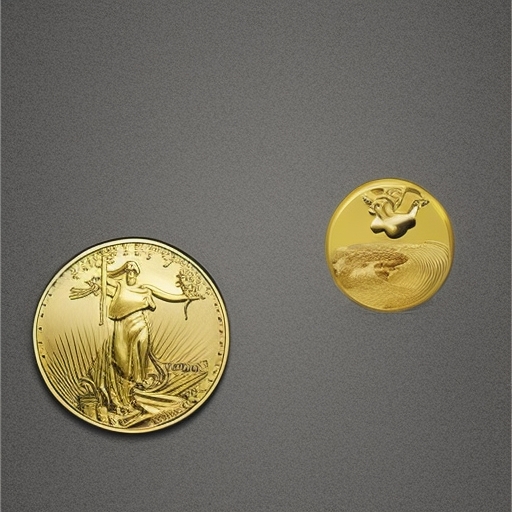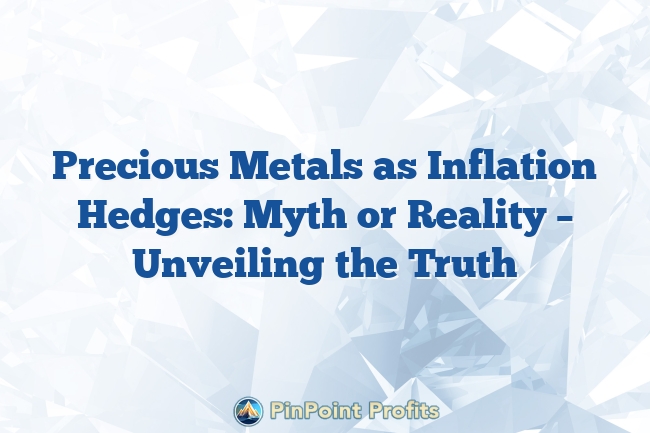If you're curious about whether precious metals are effective inflation hedges, you're in the right spot. This guide will delve into the specifics of how precious metals can protect your investments from inflation. Let's explore the nuances of this intriguing topic.
Are Precious Metals Effective Inflation Hedges?
Precious metals like gold and silver have long been considered effective hedges against inflation. Their value tends to rise when the purchasing power of currency falls. This makes them attractive for those looking to preserve wealth.
Gold, in particular, is seen as a safe-haven asset. It has historically maintained its value over time. Investors often turn to gold bullion and gold coins during economic uncertainty. This is because they offer a tangible store of value.
A Gold IRA allows investors to include physical gold in their retirement portfolio. This can be a strategic move for those seeking inflation protection. By investing in a precious metals IRA, you can diversify your assets and hedge against inflation.
| Feature | Benefit |
|---|---|
| Gold IRA | Tax-deferred investment |
| Precious metals IRA | Portfolio diversification |
| Gold bullion | Physical gold storage |
| Gold coins | Safe-haven asset |

Historical Performance of Precious Metals During Inflation
The historical performance of precious metals during inflationary periods is noteworthy. Gold has often outperformed other assets when inflation rises. This is due to its intrinsic value and limited supply.
During times of high inflation, the gold spot price tends to increase. This is because investors seek to protect their wealth. Gold bars and gold-backed IRAs become more appealing. They offer a hedge against the eroding value of currency.
Silver and platinum also play a role in inflation protection. They have industrial uses, which can drive demand. However, gold remains the most popular choice for inflation hedging. Its historical track record speaks for itself.
Factors Influencing the Value of Precious Metals
Several factors influence the value of precious metals. Supply and demand dynamics are crucial. Limited supply and high demand can drive prices up.
Geopolitical events also impact precious metal prices. Uncertainty can lead to increased demand for safe-haven assets. This includes gold and silver.
Currency fluctuations are another factor. A weaker currency can boost the value of precious metals. This is because they are priced in U.S. dollars.
Interest rates play a role as well. Lower rates can make gold more attractive. This is because it doesn't yield interest. Investors may prefer it over low-yielding bonds.
Comparing Precious Metals to Other Inflation Hedges
Precious metals are not the only inflation hedges available. Real estate, commodities, and stocks are alternatives. Each has its own advantages and risks.
Real estate can provide rental income and capital appreciation. However, it requires significant capital and management. Commodities like oil and agricultural products can also hedge against inflation. They are subject to market volatility, though.
Stocks can offer growth potential. However, they are sensitive to economic cycles. Precious metals, on the other hand, are less correlated with traditional assets. This makes them a valuable addition to a diversified portfolio.
Risks and Benefits of Investing in Precious Metals
Investing in precious metals comes with both risks and benefits. On the positive side, they offer a hedge against inflation. They also provide portfolio diversification.
Precious metals are tangible assets. This means they are not subject to the same risks as paper assets. They can preserve wealth during economic downturns.
However, there are risks to consider. Precious metal prices can be volatile. They are influenced by various factors, including market sentiment.
Storage and insurance costs are another consideration. Physical gold storage requires a secure location. This can add to the overall cost of investment.
How Do Precious Metals Protect Against Inflation?
Precious metals protect against inflation by maintaining their value. When currency loses purchasing power, gold and silver often rise in value. This is because they are seen as a store of wealth.
A self-directed IRA allows investors to include precious metals. This can provide a hedge against inflation. By holding physical gold, investors can preserve their purchasing power.
Gold mining stocks and gold ETFs are other options. They offer exposure to gold without physical ownership. However, they come with different risks and benefits.
Market Trends and Predictions for Precious Metals
Market trends for precious metals are influenced by various factors. Economic conditions, geopolitical events, and currency fluctuations all play a role.
In recent years, there has been increased interest in precious metals. This is due to concerns about inflation and economic uncertainty. Investors are seeking safe-haven assets to protect their wealth.
Predictions for precious metals vary. Some experts believe prices will continue to rise. Others caution that market volatility could impact returns.
Role of Precious Metals in a Diversified Portfolio
Precious metals play a crucial role in a diversified portfolio. They offer a hedge against inflation and economic downturns. This can help preserve wealth over the long term.
Including precious metals in a retirement portfolio can provide balance. They are less correlated with traditional assets like stocks and bonds. This can reduce overall portfolio risk.
A Gold IRA allows investors to hold physical gold. This can enhance portfolio diversification. It also offers tax advantages and inflation protection.
Expert Opinions on Precious Metals as Inflation Hedges
Experts have varying opinions on precious metals as inflation hedges. Some view them as essential for wealth preservation. Others caution about potential risks and volatility.
Many financial advisors recommend a small allocation to precious metals. This can provide diversification and inflation protection. However, they advise against overexposure.
The consensus is that precious metals can be effective hedges. However, they should be part of a broader investment strategy. This includes a mix of assets to achieve financial goals.
Common Misconceptions About Precious Metals
There are several misconceptions about precious metals. One is that they are only for wealthy investors. In reality, anyone can invest in precious metals.
Another misconception is that precious metals are always safe. While they offer protection, they are not risk-free. Prices can be volatile and influenced by various factors.
Some believe that physical gold is the only option. However, there are other ways to invest. Gold ETFs, mining stocks, and precious metals IRAs are alternatives.
Strategies for Investing in Precious Metals
There are several strategies for investing in precious metals. One approach is to buy physical gold or silver. This can be in the form of coins or bars.
Another strategy is to invest in a precious metals IRA. This allows for tax-deferred growth and diversification. It also provides inflation protection.
Investors can also consider gold ETFs or mining stocks. These offer exposure to gold without physical ownership. However, they come with different risks and benefits.
IRS Regulations and Precious Metals IRAs
Understanding IRS regulations is crucial when investing in precious metals IRAs. The IRS has specific rules about the types of metals allowed. These include certain gold, silver, platinum, and palladium coins and bars.
IRA custodians play a vital role in managing precious metals IRAs. They ensure compliance with IRS regulations. This includes proper storage and record-keeping.
It's important to note that not all precious metals qualify for IRAs. Only certain purity levels are accepted. Investors should consult with experts to ensure compliance.
Physical Gold Storage Options
Physical gold storage is a critical consideration for investors. There are several options available, each with its own pros and cons.
Home storage is one option, but it comes with risks. Security and insurance can be challenges. Many investors prefer precious metals depositories.
Depositories offer secure storage and insurance. They also provide easy access for buying and selling. Some IRA custodians have partnerships with specific depositories.
Tax Implications of Precious Metals Investments
The tax implications of precious metals investments vary. In a traditional IRA, contributions may be tax-deductible. Withdrawals are taxed as ordinary income.
For a Roth IRA, contributions are made with after-tax dollars. Qualified withdrawals are tax-free. This can be advantageous for long-term investors.
Capital gains taxes apply to profits from selling precious metals. The rate depends on how long the asset was held. Long-term capital gains typically have lower rates.
The Role of Gold in Economic Crises
Gold has historically played a significant role during economic crises. It's often seen as a safe-haven asset during turbulent times.
During financial upheavals, gold prices tend to rise. This is because investors seek stability and security. Gold's value is not tied to any specific currency or economy.
The 2008 financial crisis is a prime example. Gold prices soared as investors sought refuge from market volatility. This demonstrates its potential as a hedge against economic uncertainty.
Precious Metals vs. Cryptocurrencies
The debate between precious metals and cryptocurrencies is ongoing. Both are seen as alternative investments and potential hedges against inflation.
Precious metals have a long history of value preservation. They are tangible assets with intrinsic worth. Cryptocurrencies, on the other hand, are relatively new and more volatile.
Some investors choose to include both in their portfolios. This provides diversification across different types of alternative assets. Each has its own unique characteristics and risk profiles.

The Future of Precious Metals in a Digital World
As we move towards a more digital world, the role of precious metals is evolving. Some question their relevance in an increasingly digital economy.
However, many experts believe precious metals will remain important. They offer a tangible store of value in a world of digital assets. This physical aspect can be reassuring to investors.
Innovations like blockchain technology are being applied to precious metals. This could make trading and ownership more efficient and transparent. It's an exciting development in the precious metals market.
Environmental Considerations in Precious Metals Mining
Environmental concerns are becoming increasingly important in the precious metals industry. Mining can have significant environmental impacts. This has led to increased scrutiny and regulation.
Responsible mining practices are gaining traction. Many companies are adopting more sustainable methods. This includes reducing water usage and minimizing habitat disruption.
Investors are also considering these factors. Some are choosing to invest in companies with strong environmental records. This reflects a growing trend towards socially responsible investing.
Conclusion: Are Precious Metals a Myth or Reality as Inflation Hedges?
In conclusion, precious metals are a reality as inflation hedges. They offer a tangible store of value and protection against currency devaluation. Gold, in particular, has a long history of preserving wealth. It is a popular choice for those seeking inflation protection.
Investing in precious metals can enhance portfolio diversification. It provides a hedge against economic uncertainty. However, it is important to understand the risks involved. Prices can be volatile, and storage costs can add up.
Overall, precious metals can be a valuable addition to a retirement portfolio. They offer a hedge against inflation and economic downturns. By including them in a diversified investment strategy, investors can achieve long-term financial goals.
What is a Gold IRA?
A Gold IRA is a self-directed individual retirement account that allows investors to hold physical gold. It provides tax-deferred growth and inflation protection. It is a popular choice for those seeking portfolio diversification.
How do I invest in precious metals?
Investing in precious metals can be done through various methods. You can buy physical gold or silver, invest in a precious metals IRA, or consider gold ETFs and mining stocks. Each option has its own risks and benefits.
Are precious metals a safe investment?
Precious metals are considered a safe-haven asset. They offer protection against inflation and economic uncertainty. However, they are not risk-free. Prices can be volatile, and storage costs can add to the overall investment.

